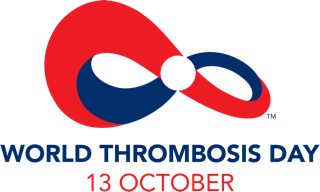
Myocardial infarction, cerebral infarction and pulmonary thromboembolism, are all caused by thrombosis. These thrombotic events either cause sudden death or a deterioration in the quality of life. Despite the seriousness of their outcome, not many people pay attention to their prevention. Although the outcomes of these thrombotic disorders are serious; their onset could be prevented using proper prophylaxis.
World Thrombosis Day (WTD) was established by the International Society on Thrombosis and Haemostasis (ISTH) to commemorate Dr. Rudolf Carl Virchow who is known as “the father of modern pathology” and established the concept of thrombosis. October 13th, the birthday of Dr. Virchow, is recognized as WTD and a variety of campaign events are organized every year in many countries worldwide.
The mission of the WTD activities are to increase global awareness of thrombosis, including its causes, risk factors, signs/symptoms and evidence-based prevention and treatment, and ultimately, to reduce death and disability caused by the condition.
Deep vein thrombosis
WTD first focused on deep vein thrombosis (DVT) and pulmonary embolism, collectively known as venous thromboembolism. DVT is caused by either: venous stasis, increase in the coagulability of the blood, disorders of the vascular wall, or combinations of these. Accordingly, the risk factors for DVT are immobilization of the body or lower extremities, during pregnancy, long flights, etc.; dehydration, oral contraceptives, obesity, cancer, etc.; and inflammation, infection, trauma, etc.
After the large earthquake hit the Kumamoto area in Japan last year, mental stress gained much attention as a risk factor for DVT.
The WTD campaign focuses on increasing public awareness of these risk factors and clinical symptoms, and to advocate for the proper use of prophylaxis. Although the evaluation of risk factors and the associated use of proper prophylaxis under risky conditionshave become common in developed countries, in many developing countries these are still not applied.
DVT in disaster situations
After the large earthquake hit the Kumamoto area in Japan last year, mental stress gained much attention as a risk factor for DVT. There was a high incidence of DVT in the population evacuated to the shelter after this earthquake.
Since this earthquake was associated with frequent and strong aftershocks, the evacuees were exposed to many panic episodes. Together with other risk factors experienced whiles inconveniently staying in a shelter, such as limited physical exercise, the fear of possible aftershocks seemed to have contributed to the development of DVT. During major disasters, periodic checkups using ultrasonography and appropriate guidance by a medical team should be considered to prevent DVT.
Highlighting atrial fibrillation
 From this year, WTD is also putting the spotlight on atrial fibrillation (AFib), which directly causes ischemic stroke. Though many people are aware of ischemic stroke as well as AFib, not so many know that AFib is a direct cause of ischemic stroke. The campaign focuses on increasing such awareness as well as advocating checking the existence of AFib by feeling their own pulse.
From this year, WTD is also putting the spotlight on atrial fibrillation (AFib), which directly causes ischemic stroke. Though many people are aware of ischemic stroke as well as AFib, not so many know that AFib is a direct cause of ischemic stroke. The campaign focuses on increasing such awareness as well as advocating checking the existence of AFib by feeling their own pulse.
The recent development of direct oral anticoagulants and advances in catheter ablation techniques indeed help to decrease the risk of ischemic stroke even when AFib together with other risk factors exist.
Awareness and education are critical to preventing thrombosis and promoting high quality of life. Your participation in the WTD campaign is critical to promoting the understanding of thrombosis, and to spread the awareness.
About Thrombosis Journal
BMC’s Thrombosis Journal regularly publishes content which covers all areas of thrombosis, including the diagnosis of arterial and venous thrombosis, new antithrombotic treatments and new developments in the understanding, diagnosis and treatments of atherosclerotic vessel disease. The journal recently published a research article that discusses the treatment of patients with upper extremity deep vein thrombosis with direct oral anticoagulants.
Comments